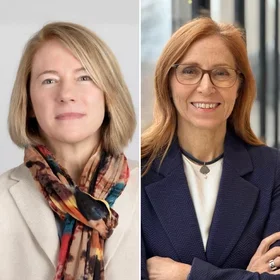Since the 1980s, I’ve been engaged in educating environmental professionals, and as the planet continues to degrade, the complexity and urgency of that task has grown. In 1987, I began an environmental policy concentration at Columbia University’s School of International and Public Affairs. In 2002, I led a team at Columbia’s Earth Institute and School of International and Public Affairs that launched an MPA in Environmental Science and Policy: an environmental policy degree requiring students to enroll in environmental science courses.
Our goal was to educate a new type of sustainability professional who could translate environmental science to non-scientific managers. Last year we welcomed our 20th class to that program. In 2008 and 2009, I started to combine my work in environmental policy with my study of organizational management. Columbia University Press published my book, Sustainability Management, and in 2010, Columbia’s Earth Institute (now Climate School) and School of Continuing Education (now School of Professional Studies) welcomed our first master’s students in Sustainability Management. This fall, we welcome our 13th class, and our total enrollment now exceeds 400 students. About two-thirds of our students attend evening classes part-time and work during the day, and our students are diverse, talented, and mission-driven. The professional field we are preparing our students to work in has evolved in many ways since we began the program, as have our course offerings.
Despite that change, the fundamental principle of the Sustainability Management program remains. The field of management itself has changed, and CEOs not only need to understand strategy, marketing, finance, human resources, performance measurement, and globalization, but also the physical dimensions of sustainability: the organization’s use of energy and other resources, waste management, and environmental risk and impact. As the field of sustainability management has evolved, environmental sustainability remains a subfield of this broader construct. Over the past decade, other subfields have been added to sustainability management. The first is diversity, equity, inclusion, and access. In a brain-based economy, managers of sustainable organizations must attract and retain talent. To do that, xenophobia, racism, homophobia, sexism, and religious bigotry such as antisemitism must be eliminated from organizational culture. It needs to be replaced by a welcoming culture of tolerance, kindness, and inclusion. The second subfield is organizational governance, which calls for transparency and diversity. The third subfield in sustainability management is community impact. What impact does the organization have on the community, cities, and nations it operates within? Each of these plays a role in organizational and planetary sustainability and stability.
Sophisticated private, public, and nonprofit organizations are looking for people who understand the various subfields of sustainability management. Over the past decade, our program has added numerous courses addressing these issues. We now offer over 60 courses, including classes in:
- The Circular Economy
- Life Cycle Analysis
- Green Accounting
- Corporate Sustainability Reporting,
- Measuring Greenhouse Gas Emissions
- Energy and Sustainable Development
- Innovative Sustainability Leadership
- Environment and Social Governance (ESG)- Aligned Corporate Governance
- Environmental Law and Justice in New York City
- Applied Corporate Social Responsibility in the Apparel Industry
- Fashion Policy and the Politics of Social Change
- Art and Sustainability
- Sustainability Metrics
- The Earth’s Climate System
- Impact Finance
- Geographies of Environmental Justice and Sustainability
- Reversing the Biodiversity Crisis
And many, many more. Our fall sustainability management course offerings are found here, the courses we are offering this summer are posted here, and while we are still revising next spring’s course schedule, the course we offered last semester are here.
The structure of our Sustainability Management master's curriculum was designed to evolve along with the field. While we require our students to complete courses in specific fields of study, the master’s program only includes two specific required courses. Our curriculum is structured by fields, within which students shape their own course of study to meet the diverse and growing needs of our field. Our courses are organized into the following five subfields:
- Integrative Courses in Sustainability Management
- Economic and Quantitative Analysis
- The Physical Dimensions of Sustainability Management
- Public Policy
- General and Financial Management
Our goal is to equip students with a conceptual framework for understanding our evolving field and a general understanding of organizational management, finance, and quantitative analysis. We also hope to provide an in-depth understanding of specific sustainability issues and skills. Finally, we strive to provide experiential learning through project group work and pro-bono service to non-profit and government organizations in our capstone client projects.
From the very start, our students have been professionally-oriented and mission-driven. They host conferences and invite prominent sustainability practitioners to come to campus. With over 1,000 graduates, we seem to be at the center of constant engagement with a dedicated and highly capable community of sustainability practitioners. When we saw the sudden increase in student interest in our program this past year, we were able to recruit over a dozen alums to teach additional sections of high-demand courses, as well as new courses designed by some of the program’s talented and experienced graduates.
At its heart, Sustainability Management is a management degree. Our goal is to equip professionals to lead the organizations that are taking shape as the 21st century evolves. Climate change, biodiversity loss, COVID-19, the disruption of global supply chains, and aggressive wars by authoritarian leaders like Vladimir Putin in Russia and Bashar Hafez al-Assad in Syria present a series of challenges and risks to modern managers. In the United States, we see political polarization and a breakdown of social consensus. All of this makes the job of organizational management more and more complex. Our Sustainability Management program requires a course in public policy because all organizations—public and private—must navigate the political environment. Organizations are regulated and constrained by public opinion.
A key message of our curriculum and program is the need to develop the agility to deal with constant change. Traditional academic fields are slow to change. Professional education requires constant change and experimentation. While the fundamentals in management remain, the application of those concepts continues to be transformed. Of the Sustainability Management program’s 12 courses, only the first and last courses are required. The first is the survey course in Sustainability Management, and the last is the capstone client workshop. I teach the Sustainability Management course—which changes every year. In recent years I’ve added sessions on diversity and environmental justice, professional development, and supply chains. Each year I drop four or five cases that have fallen out of date and replace them with new cases. This year I am also including readings from a book I am still writing on a “realistic transition to environmental sustainability.”
In addition to the Sustainability Management program’s focus on flexibility and part-time students, another carefully designed path to professional careers in sustainability is the MPA in Environmental Science and Policy program I direct at the School of International and Public Affairs (SIPA). That MPA program requires a year of intense dedicated study, and unlike the sustainability management program, its curriculum is highly prescriptive and includes a summer of environmental science courses taught by Earth Institute/Climate School faculty and researchers. This approach to professional preparation differs from the Sustainability Management program, although many of the MPA students enroll in electives offered by the Sustainability Management program. SIPA’s program requires a traditional public policy core: a year of economics, quantitative analysis, courses in management and financial management, along with courses on politics, policy, and public ethics. The MPA in Environmental Science and Policy offers its own core courses distinct from SIPA’s school-wide core, and so students learn sustainability management, environmental economics and finance, and environmental ethics. The core concepts are the same as a typical policy program but are applied to issues of environmental sustainability. The program also features a three-semester integrative workshop sequence which includes a two-semester management simulation and a client-based capstone project. Students learn how to integrate science, policy, and management to solve difficult issues of environmental sustainability. They work in small groups and learn how to work together under the same tight deadlines they will face as sustainability professionals.
This program features a cohort that stays together in most of the program’s courses throughout an intense year of full-time study that begins in late May and ends the following May. Over these three semesters, the cohort completes a 54-point degree. Its graduates include a number of prominent sustainability leaders in the public, private, and nonprofit sectors. That program’s curriculum has evolved along with the field over the past two decades. We added urban ecology, toxic risk analysis, a focus on diversity equity and inclusion, and our course in public management has evolved into a course in sustainability management. Originally, the program had no electives; today, it has three, enabling students to focus on subfields of sustainability management.
For me, the most inspiring part of leading both Columbia’s MS in Sustainability Management and MPA in Environmental Science and Policy is the dedication and spirit of our students. In both programs—one more private sector focused and the other more public sector oriented—our students are dedicated, idealistic, and caring. They care for their own student community but also for the well-being of the planet. One of the reasons I remain optimistic about our future is that I get to teach and learn from these talented, visionary, and hard-working students. If anyone can save the world, it will be these incredible, wonderful students and alums. Our graduates are well-prepared sustainability professionals with a track record that demonstrates both the success of our educational experiment and their own phenomenal talent.
This article was originally published in State of the Planet.



